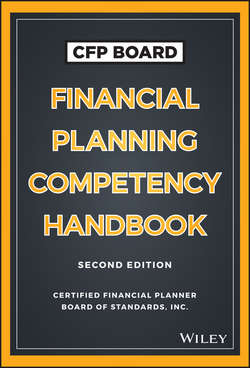Читать книгу CFP Board Financial Planning Competency Handbook - Board CFP - Страница 47
На сайте Литреса книга снята с продажи.
PART One
Introduction
CHAPTER 8
Cash Flow Management
ОглавлениеMartie Gillen, PhD
University of Florida
Michael Gutter, PhD
University of Florida
CONNECTIONS DIAGRAM
Cash flow management is a fundamental aspect of financial planning. Therefore, cash flow management connects to all areas of financial planning. The construction of financial statements provides a foundation for identifying opportunities and challenges related to a client’s cash inflows and outflows. The financial planner can use this information to help clients develop a plan for reaching long-term financial goals such as planning for education, special circumstances, and retirement. Financing strategies may be utilized to aid the client in reaching goals such as buying a home. Cash inflows and outflows play an important role in determining whether obtaining new debt is the best alternative, including the debt level. Time value of money (TVM) is an important financial planning concept and includes calculations needed to assist with financial goal planning. TVM can be used by the financial planner to help a client compare alternatives among investments, loans, mortgages, leases, savings, and annuities. The financial planner should communicate recommendations to assist clients in meeting their current financial needs and long-term financial goals, including the need for liquid assets and emergency funds, as well as recommending strategies for accumulating the appropriate levels of funds. The financial planner must adhere to ethical standards of professional conduct and fiduciary responsibility.
INTRODUCTION
Cash flow management is an essential component of financial planning. Cash flow management involves understanding the components that make up where the client’s money comes from, where it goes, and what choices are appropriate in meeting the client’s needs and goals. It is critical that financial planners understand cash flow management to be able to make recommendations to clients to assist them in meeting their current needs and long-term financial goals. The overall goal of cash flow management is to efficiently meet current consumption needs while maximizing capital for additional financial management activities needed to reach clients’ objectives.
The primary components of cash flow management include income, fixed expenses, variable expenses, and savings contributions. Income earned by the client may include salary, interest, dividend, pension, business income, and alimony received. Examples of fixed expenses include mortgage payments, automobile payments, student loan payments, property taxes, insurance premiums, and federal and state income tax withholdings. Variable expenses are more discretionary than fixed expenses over the short term, and include items such as entertainment expenses and vacation expenses.
The statement of income and expenses is a financial statement that represents all of the client’s income, including both earned and expected income, less all expenses incurred during the specified time period. This statement is typically prepared on an annual basis but can be prepared for a monthly or quarterly period of time. Additionally, the statement of income and expenses does not include non-recurring transactions such as the sale of stock or an employer’s contribution to a retirement plan. Understanding a client’s cash flow can provide valuable information in understanding a client’s financial priorities by providing a snapshot of the client’s financial situation. The statement of income and expenses should be viewed with the balance sheet to provide the financial planner with a more accurate picture of a client’s financial situation.
The financial planner should identify opportunities and challenges related to a client’s cash inflows and outflows. For example, having a positive cash flow will afford the client options to save for long-term goals such as education and retirement. Conversely, a negative cash flow may lead the client to having excess debt and additional costs due to interest. The financial planner should calculate the amount of savings required to meet the client’s financial goals and recommend how to incorporate planned saving contributions into the cash flow plan. The financial planner should also communicate the need for liquid assets and emergency funds and recommend strategies for accumulating the appropriate levels of funds. The financial planner should also work with clients to identify non-financial resources that clients may use to achieve financial goals. Understanding a client’s cash flow plan is essential to financial planning.
Конец ознакомительного фрагмента. Купить книгу
